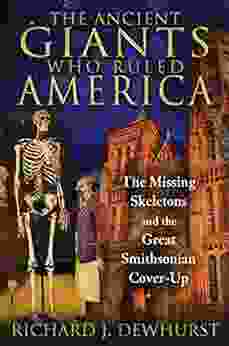The Missing Skeletons: Exposing the Great Smithsonian Cover-Up

In-depth Analysis of the Shocking Discovery That Changed History
The Smithsonian Institution, a venerable institution of scientific research and public education, has long been a pillar of American academia and culture. However, beneath its hallowed halls lies a dark secret that has haunted the world of science for decades: the missing skeletons.
In the early 20th century, the Smithsonian acquired an extraordinary trove of human remains from the American Southwest. These skeletons were believed to belong to the extinct Clovis people, the first known inhabitants of North America. However, subsequent research revealed startling discrepancies between these remains and the established Clovis timeline.
4.5 out of 5
| Language | : | English |
| File size | : | 8711 KB |
| Text-to-Speech | : | Enabled |
| Enhanced typesetting | : | Enabled |
| X-Ray | : | Enabled |
| Word Wise | : | Enabled |
| Print length | : | 374 pages |
| Screen Reader | : | Supported |
The skeletons were inexplicably missing, sending shockwaves through the scientific community and sparking allegations of a massive cover-up. This article will delve into the fascinating story of the missing skeletons, exploring the evidence, the controversies, and the profound implications for our understanding of human history.
The Mysterious Discovery
In 1912, Smithsonian anthropologist Aleš Hrdlička led an expedition to the American Southwest in search of evidence of the Clovis people. At the Folsom site in New Mexico, Hrdlička discovered three human skeletons associated with distinctive stone tools, later named Folsom points.
Based on these finds, Hrdlička proposed that the Clovis people, named after the Clovis, New Mexico site where similar artifacts had been found, lived approximately 13,000 years ago. They were believed to be skilled hunters who played a significant role in the extinction of the megafauna that roamed North America at the time.
Discrepancies and Doubts
As more Clovis skeletons were discovered in the following decades, researchers began to notice inconsistencies with Hrdlička's original assessment. Some skeletons appeared to be significantly older than 13,000 years, while others showed evidence of genetic affinities to later Native American groups.
The most perplexing discrepancy was with the Kennewick Man, found in Washington State in 1996. This well-preserved skeleton was dated to nearly 9,000 years ago and exhibited skull characteristics that were unlike any known Native American group.
These findings raised serious doubts about the accuracy of the established Clovis timeline and the assumptions about the origins of the Clovis people.
Allegations of a Cover-Up
As the scientific evidence mounted against the Clovis theory, some researchers began to speculate that the Smithsonian was deliberately suppressing the truth. They argued that the missing skeletons and the discrepancies in their dating were part of an attempt to uphold the long-held belief in the Clovis people as the first Americans.
In 2001, journalist J. Maarten Troost published a bombshell report in the Washington Post, accusing the Smithsonian of covering up the existence of pre-Clovis skeletons. Troost's article cited confidential documents and interviews with anonymous scientists who claimed to have witnessed the suppression of evidence.
The Smithsonian vehemently denied these allegations, dismissing them as "unfounded rumors." However, the controversy refused to subside, and calls for an independent investigation continued to grow.
The NAGPRA Act and Its Impact
In 1990, the Native American Graves Protection and Repatriation Act (NAGPRA) was passed, giving Native American tribes the right to repatriate the remains of their ancestors from institutions like the Smithsonian.
The repatriation process forced the Smithsonian to re-evaluate its collections and resulted in the return of thousands of skeletal remains to their rightful owners. This process also brought the issue of the missing skeletons back into the spotlight.
In 2012, the Kennewick Man remains were repatriated to five Native American tribes, including the Confederated Tribes of the Umatilla Indian Reservation and the Colville Confederated Tribes. This decision was seen as a victory for Native American sovereignty and a step towards acknowledging the true diversity of human history in North America.
The Legacy of the Missing Skeletons
The missing skeletons scandal has left a profound mark on the field of archaeology and our understanding of human evolution. The controversy has challenged long-held assumptions about the origins of the Clovis people and raised fundamental questions about the role of scientific institutions in shaping historical narratives.
The case has also highlighted the importance of transparency and accountability in scientific research. It has shown that even the most respected institutions are not immune to manipulation and suppression of evidence.
Today, the search for the missing skeletons continues, and researchers are employing new technologies to shed light on this enduring mystery. As they delve deeper into the past, they may uncover even more secrets that will rewrite our understanding of human history.
The missing skeletons and the Great Smithsonian Cover-Up is a fascinating and complex story that has reverberated through the scientific community for decades. It is a tale of scientific discovery, controversy, and the struggle for truth and reconciliation.
As we continue to explore the mysteries of our past, it is important to remember the lessons learned from the missing skeletons. We must be vigilant in our pursuit of knowledge, critical of our assumptions, and committed to transparency and accountability in all walks of life.
The true legacy of the missing skeletons lies not only in the bones themselves but in the reminder that history is a living and evolving construct, shaped by both the discoveries we make and the choices we choose to make. Let us hope that future generations will learn from the mistakes of the past and embrace the quest for knowledge with open minds and open hearts.
4.5 out of 5
| Language | : | English |
| File size | : | 8711 KB |
| Text-to-Speech | : | Enabled |
| Enhanced typesetting | : | Enabled |
| X-Ray | : | Enabled |
| Word Wise | : | Enabled |
| Print length | : | 374 pages |
| Screen Reader | : | Supported |
Do you want to contribute by writing guest posts on this blog?
Please contact us and send us a resume of previous articles that you have written.
 Book
Book Novel
Novel Page
Page Chapter
Chapter Text
Text Story
Story Genre
Genre Reader
Reader Library
Library Paperback
Paperback E-book
E-book Magazine
Magazine Newspaper
Newspaper Paragraph
Paragraph Sentence
Sentence Bookmark
Bookmark Shelf
Shelf Glossary
Glossary Bibliography
Bibliography Foreword
Foreword Preface
Preface Synopsis
Synopsis Annotation
Annotation Footnote
Footnote Manuscript
Manuscript Scroll
Scroll Codex
Codex Tome
Tome Bestseller
Bestseller Classics
Classics Library card
Library card Narrative
Narrative Biography
Biography Autobiography
Autobiography Memoir
Memoir Reference
Reference Encyclopedia
Encyclopedia Penny Chamberlain
Penny Chamberlain Kimberly A Whitler
Kimberly A Whitler Linda Byler
Linda Byler Mallory Loehr
Mallory Loehr Matthew Jm Carpenter
Matthew Jm Carpenter Peter Liljedahl
Peter Liljedahl Rebecca Soffer
Rebecca Soffer Maura Weis
Maura Weis Tariq Ali
Tariq Ali Greg King
Greg King Rachel Aukes
Rachel Aukes Lola M Schaefer
Lola M Schaefer Sam Wilkin
Sam Wilkin Tim Lebbon
Tim Lebbon Lou Adler
Lou Adler Sandra Francis
Sandra Francis Tracy Vonder Brink
Tracy Vonder Brink Wendy Bernard
Wendy Bernard Terrence Real
Terrence Real Ricardo C Amaral
Ricardo C Amaral
Light bulbAdvertise smarter! Our strategic ad space ensures maximum exposure. Reserve your spot today!

 Dustin RichardsonHockey Rules Strategy Guide: Unlock the Secrets of the Game and Dominate the...
Dustin RichardsonHockey Rules Strategy Guide: Unlock the Secrets of the Game and Dominate the...
 August HayesSouthern Cooking Recipes: A Culinary Journey to the Heart of American Cuisine
August HayesSouthern Cooking Recipes: A Culinary Journey to the Heart of American Cuisine Mark TwainFollow ·5.7k
Mark TwainFollow ·5.7k Richard SimmonsFollow ·9.2k
Richard SimmonsFollow ·9.2k Jay SimmonsFollow ·11.7k
Jay SimmonsFollow ·11.7k Nick TurnerFollow ·4.1k
Nick TurnerFollow ·4.1k Calvin FisherFollow ·12.7k
Calvin FisherFollow ·12.7k Clarence MitchellFollow ·12.5k
Clarence MitchellFollow ·12.5k Marvin HayesFollow ·13.8k
Marvin HayesFollow ·13.8k Orson Scott CardFollow ·19.8k
Orson Scott CardFollow ·19.8k

 Brian Bell
Brian BellExploring The Natural World Through Mindful Expressive...
Unleash the...

 David Baldacci
David BaldacciJourney into the Enigmatic World of "Grass" by Sheri S....
Prepare to be captivated by "Grass," a...

 Dashawn Hayes
Dashawn HayesBusting Myths About Human Nature: Unraveling the Complex...
Challenging the...

 Ernest Hemingway
Ernest HemingwayNotes on Suicide: A Profound Exploration of the...
Suicide, a taboo subject shrouded in...
4.5 out of 5
| Language | : | English |
| File size | : | 8711 KB |
| Text-to-Speech | : | Enabled |
| Enhanced typesetting | : | Enabled |
| X-Ray | : | Enabled |
| Word Wise | : | Enabled |
| Print length | : | 374 pages |
| Screen Reader | : | Supported |












